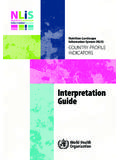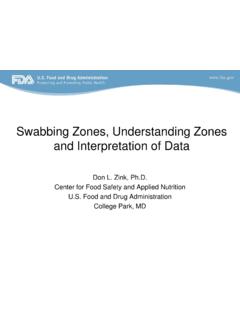Transcription of Using interpretative phenomenological analysis for public ...
1 Using interpretative phenomenological analysis for public healthnutrition and dietetic research: a practical guideStephanie FadeDepartment of nutrition and Dietetics, Royal Brompton Hospital, Sydney Street, London SW3 6NP, UKThe present paper introduces interpretative phenomenological analysis (IPA) as a frameworkfor analysing qualitative research data collected for public health nutrition and dietetic researchstudies. The theoretical roots of IPA have been set out briefly in order to help researchersdecide whether the approach is relevant for them and their particular research questions. IPAcan be used to analyse data from one-to-one interviews in order to develop thick descriptions that may help illuminate human experience. IPA can also be used to develop theories and/ormodels, which could help inform policy.
2 The main body of the paper describes the analyticaltechniques and procedures used to achieve both outcomes in a practical way, Using examplesfrom the author s own research. In the following paper Krueger s methods for analysing focusgroup data are set out for comparison. It is hoped that these papers will empower researcherswith little experience of qualitative research to develop confidence with qualitative dataanalysis. In addition, it is hoped that the material will stimulate debate amongst moreexperienced qualitative researchers from a public health or dietetic phenomenological analysis : Qualitative research: nutrition : DieteticsIt is important that qualitative research reports give enoughmethodological details to enable readers to understandwhat has been done and so make a judgement about thequality and usefulness of the work.
3 However, qualitativeresearch techniques are complex and full explanations areoften difficult to achieve within the constraints of the wordlimits set by journals. Using a recognised framework canbe helpful as long as readers understand what the frame-work entails (Fade, 2003). interpretative phenomenologicalanalysis (IPA) is one such framework, which was devel-oped and described by Smithet al. (1995, 1997, 1999).IPA can be used to develop in-depth descriptions of humanexperience. The techniques can also be taken further todevelop theories, models and explanations that help usunderstand human experience better. The present paperseeks to describe IPA for nutritionists and dietitians,drawing on the author s experience of Using rootsIPA has its origins in health psychology (Smithet al.)
4 1995,1997, 1999) and is theoretically rooted in critical realism(Bhaskar, 1978) and the social cognition paradigm (Fiske& Taylor, 1991). Critical realism accepts that there arestable and enduring features of reality that exist indepen-dently of human conceptualisation. Differences in themeanings individuals attach to experiences are consideredpossible because they experience different parts of social cognition paradigm is founded on the premisethat human speech and behaviour reflects these differencesin meaning either directly or indirectly. Hence, analysis ofinterview data is considered to be a reasonable method ofaccessing and developing an understanding of label IPA is interesting and has been the cause ofsome debate (Willig, 2001). Phenomenology is concernedwith human understanding and originated in the ideas ofEdmund Husserl, first put forward in 1936 (Husserl, 1970).
5 He rejected the view that empirical science is the basis forachieving an understanding of the world, stressing insteadthe importance of the life world or lived experience. Hebelieved that the core meaning of entities in the world canbe understood by intuition. In other words, what is reallythere in the world can be understood by perceiving it ina manner that is uncontaminated by an individual s pastexperiences and viewpoints. It is this thinking that hasAbbreviation:IPA, interpretative phenomenological author:Stephanie Fade, fax+44 207351 8990, email of the nutrition Society(2004),63, 647 653 Author 2004inspired much recent research in healthcare, in which thefocus is on exploring individual lived experiences .Traditionally, researchers carrying out phenomenologystudies have aimed to bracket out their preconceptions(Colaizzi, 1978; Moustakas, 1994) Using formal reflexivetechniques (Heron, 1990; Duck, 1992).
6 It has been arguedthat true phenomenological research should also requirerespondents to engage with these reflexive techniques inorder to give a more accurate representation of the way inwhich they see the world pre-cognitively (Caelli, 2001).From this standpoint it could be argued that IPA has beenwrongly labelled as phenomenological . Smithet al.(1999) stress that the purpose of IPA is to attempt as faras possible to gain an insider perspective of the phenomenonbeing studied, whilst acknowledging that the researcher isthe primary analytical instrument. The researcher s beliefsare not seen as biases to be eliminated but rather as beingnecessary for making sense of the experiences of otherindividuals. Reflexivity is viewed as an optional tool,enabling the researcher to formally acknowledge his or herinterpretative role, rather than as an essential technique forremoving bias.
7 Based on a Husserlian view it could beargued that analysis cannot be both interpretative andphenomenological. However, it is important to understandthat phenomenological thought has been developed in avariety of different ways. For example, in 1927 Heidegger(1962) stressed the importance of being in the world and,hence, the inevitability of the world being perceivedthrough the lens of historical context and socio-culturalbackground. Gadamer (1976), too, presented the past asproductive, shaping the interpreter s present is phenomenological in that it seeks an insiderperspective on the lived experiences of individuals, andinterpretative in that it acknowledges the researcher spersonal beliefs and standpoint and embraces the view thatunderstanding requires to research in the field of nutritionNutritionists and dietitians who wish to explore and/ordevelop theories for the shared meanings that a group ofindividuals attaches to a particular lived experience couldmake use of IPA as a framework for qualitative dataanalysis.
8 In addition, the case-study approach to IPA (seep. 648) can be used to develop an in-depth descriptionof just one individual s experience, where this seemsappropriate. IPA may be particularly useful when theresearcher s personal stance is that certain values andbeliefs are likely to remain outside his or her conscious-ness (Luft, 1969), and that as a consequence it would beimpossible to bracket them out even with the use of formalreflexive techniques. IPA is applied to interview data andso the researcher needs to have access to a pool ofpotential respondents who have experienced the phenom-enon in question. For example, IPA could be used toexplore the core meaning of healthy eating from theperspective of a group of African Caribbean teenagers orto look at the experiences of UK Muslim women inrelation to breast-feeding.
9 IPA is also useful for carryingout research with healthcare professionals. For example,it could be used to explore nurses perceptions of enteralfeeding for patients with cancer or house-officers percep-tions of the role of the dietitian in the methodSmithet al. (1999) describe two approaches to IPA. Thefirst is the basic method, termed the ideographic case-studyapproach. This method is suitable for small samples of upto ten respondents and enables the researcher to write up asingle case or an exploration of themes shared betweencases. Additional procedures are recommended for largersample sizes and for exploring patterns and relationshipswithin and between conceptual groups. These procedurescan be particularly useful when a theoretical explanation ormodel is the desired outcome of the research as opposed toin-depth description.
10 For example, a researcher may wishto develop a model to explain the attitudes of UK Muslimwomen towards breast-feeding or nurses perceptions ofthe role of enteral feeding. Both approaches will beintroduced ideographic case-study approachThis approach is recommended for the exploration anddevelopment of in-depth descriptions from a single caseor shared themes from up to ten cases (Smithet al. 1999).IPA is applied to interview data, which should be recorded(on audio tape) and transcribed verbatim. Set questionsor pre-ordained lists of themes are not usually used, asthe purpose of the research is to explore the respondents perceptions of what is important in relation to the phe-nomenon in question, rather than to look at what theresearcher deems important. It is helpful to keep field notesdescribing non-verbal communication and the researcher sgeneral impressions of issues such as the tone of theinterview and the respondent s ability to retrieve informa-tion for discussion.















